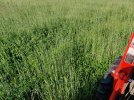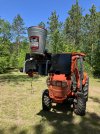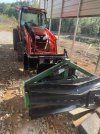Bowsnbucks
5 year old buck +
If I may, I'd like to ask how this cover-cropping, soil-building strategy applies to those of us who aren't farmers with roller-crimpers, and who don't rotate into cash crops following a winter cover crop - whatever crop / seed mix that may be. Many of these soil-building videos are done by commercial farmers FOR commercial farmers. I understand why they apply these methods.
I also understand WHY cover-cropping / soil-building is good for hunters / food-plotters. It's about soil health. But in practical terms for hunting camps in non-ag areas, people like us need a CHART of crop varieties to plant, DATES / TIMES to plant them, best ways to TERMINATE the cover crops (for $$ efficiency), what crops to follow up with after terminating the fall / winter cover crop to establish another good food plot for deer, and what food plot crops can be seeded into what for good establishment / longevity.
You guys who are farmers already understand much of this info. Those of us not raised on farms are NEWER to this info. We don't have grain drills & some of the other equipment you gents have. We use broadcast spreaders by hand or on a 4-wheeler. Timing is a big question for us as to terminating a cover crop - or an older food plot that's run its course.
We have planted mixed clover plots with rye or oat nurse crops around Labor Day for fall & winter food and establishing a multi-year clover plot going forward. We also plant a mix of brassicas in late July (which also has some red clover in it). If we were to plant something following rye, winter wheat, or oats - WHEN should we terminate the grains? ( I saw the video of rye being rolled AFTER it makes pollen tubes). What about oats & wheat? Should the follow-up crop be seeded FIRST - then rolled or sprayed - in order to get more seed down to the soil, or seed AFTER rolling the rye, oats, or wheat down?
For soil building & cost efficiency - could we establish a mixed-variety plot and just scratch the soil with a disc each fall & overseed new crops into the established mixed plot? (Say, turnips, radishes, red clover, rye, oats, chicory for a mixed variety plot). With rye in that mixed plot, what should we do with it the following spring??? Could a mixed plot be kept going for 5 to 7 years just by scratching with a disc and overseeding each fall???
OPEN to any & all suggestions.
I also understand WHY cover-cropping / soil-building is good for hunters / food-plotters. It's about soil health. But in practical terms for hunting camps in non-ag areas, people like us need a CHART of crop varieties to plant, DATES / TIMES to plant them, best ways to TERMINATE the cover crops (for $$ efficiency), what crops to follow up with after terminating the fall / winter cover crop to establish another good food plot for deer, and what food plot crops can be seeded into what for good establishment / longevity.
You guys who are farmers already understand much of this info. Those of us not raised on farms are NEWER to this info. We don't have grain drills & some of the other equipment you gents have. We use broadcast spreaders by hand or on a 4-wheeler. Timing is a big question for us as to terminating a cover crop - or an older food plot that's run its course.
We have planted mixed clover plots with rye or oat nurse crops around Labor Day for fall & winter food and establishing a multi-year clover plot going forward. We also plant a mix of brassicas in late July (which also has some red clover in it). If we were to plant something following rye, winter wheat, or oats - WHEN should we terminate the grains? ( I saw the video of rye being rolled AFTER it makes pollen tubes). What about oats & wheat? Should the follow-up crop be seeded FIRST - then rolled or sprayed - in order to get more seed down to the soil, or seed AFTER rolling the rye, oats, or wheat down?
For soil building & cost efficiency - could we establish a mixed-variety plot and just scratch the soil with a disc each fall & overseed new crops into the established mixed plot? (Say, turnips, radishes, red clover, rye, oats, chicory for a mixed variety plot). With rye in that mixed plot, what should we do with it the following spring??? Could a mixed plot be kept going for 5 to 7 years just by scratching with a disc and overseeding each fall???
OPEN to any & all suggestions.





